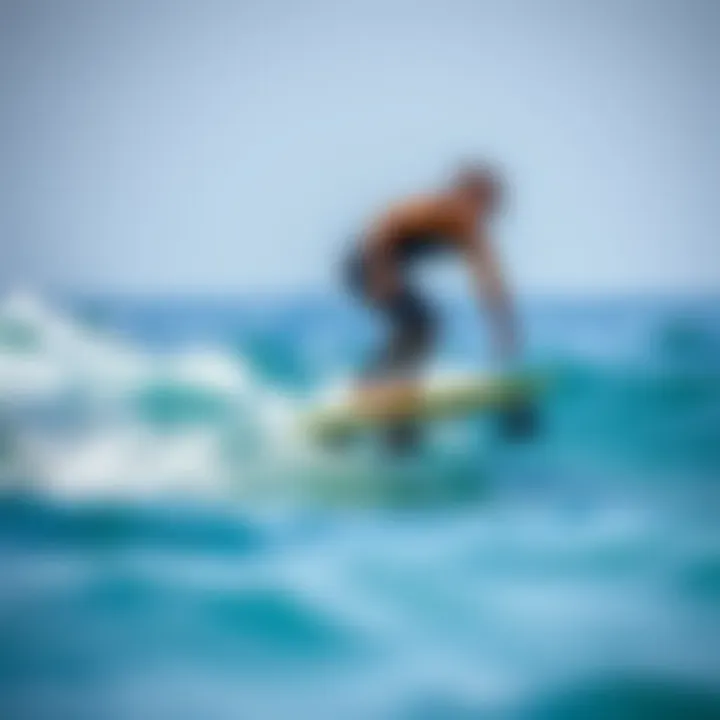How to Choose the Perfect Longboard for You


Intro
Choosing a longboard can feel like venturing into a maze without a map—at first glance, it seems overwhelmingly complicated. Various models, styles, colors, and materials flood the market. However, understanding some basic principles can help you make a confident choice that aligns with your riding style and preferences. Just like finding the perfect pair of shoes, selecting a longboard is about comfort, compatibility, and achieving your cruising goals.
The fascinating world of longboards isn’t just about gliding down the street; it's about expressing individuality, enjoying the outdoors, and mastering a skill that’s both exhilarating and freeing. In this guide, we’ll break down every essential element you need to consider. We’ll look into board types, materials, design features, and sizing—allowing you to navigate through options with ease.
Before diving headfirst into the details, let's consider this: the right longboard means you’ll enjoy your rides more. It’s essential to avoid common pitfalls that many first-time buyers face, like opting for a visually appealing board without understanding its functional aspects. Empowering yourself with knowledge keeps you from buying a board that, while flashy, might not serve your needs adequately or could even compromise your safety.
So, if you’re eager to explore the intricacies of longboard selection, let’s unpack this journey together. Grab your favorite snack and let’s dive deep into what makes a longboard right for you.
Understanding Longboarding
Longboarding isn't just about picking a plank with wheels. It's an experience; a way to navigate through life on four wheels. Understanding longboarding is essential before even thinking about which board to choose. It allows riders to connect with their preferences, better appreciate various techniques and styles, and ultimately make informed decisions that align with their riding aspirations. Learning the intricacies of longboarding can also foster a deeper appreciation for the craftsmanship and engineering behind the boards, ensuring riders choose a longboard not just for its looks but for how it responds under their feet.
Historically, longboarding has morphed from simple transportation to a lifestyle and a sport. This evolution reflects changes in culture and technology, shaping the equipment and styles we see today. Thus, grasping this fact helps enthusiasts to appreciate where longboarding stands in the broader context of skating and sports altogether.
The Evolution of Longboarding
Longboarding, in its essence, grew from surfing. Surfers sought a way to get the feeling of gliding on waves even when the ocean was calm. In the mid-1950s, they started making boards longer and wider, becoming what we now know as longboards. This initial tinkering stimulated ongoing innovation, resulting in numerous designs suited to different riding styles. As years went by, technological advancements in materials and design took the sport from mere novelty to mainstream appeal.
Consequently, longboarding's expansion gave rise to subcultures, each distinguished by unique aesthetics and purposes. From communal rides to competitive racing, these divisions express the versatility of longboarding. Meanwhile, this progression equally beckons modern riders to reflect on their preferences as they step into this vibrant sector.
Different Longboarding Disciplines
A critical aspect of choosing your longboard lies in understanding the various disciplines, each with its own distinct characteristics and demands. Whether you want to cruise along the sidewalk or reach thrilling speeds down hills, knowing the differences is paramount.
Downhill
Downhill longboarding is all about speed and control. Riders tackle steep hills while maintaining stability at higher velocities. The boards designed for this discipline are typically longer and feature a lowered center of gravity, providing enhanced stability and reducing wheel bite. The most attractive aspect of downhill riding is the adrenaline rush it provides. Riders feel a unique connection with gravity, zipping down hills as the world rushes past in a blur.
However, the flipside of downhill longboarding is the risk involved. At high speeds, even small mistakes can lead to falls that may cause injury. Moreover, it requires riders to be vigilant about road conditions and traffic, which can limit places to ride.
Freeride
Freeriding combines tricks and speed, creating a unique blend where riders can slide and drift while cruising downhill. This discipline emphasizes style and creativity rather than just straight-line speed. Freeride boards tend to be all-around versatile, enabling riders to engage in sliding, drifting, and kicking out their tails to perform tricks.
The focus on control allows riders to explore their creative side. As a downside, engaging in freeride can lead to wear on the wheels and may necessitate more frequent replacements. It also requires an understanding of how to slide properly to prevent falling.
Freestyle
Freestyle longboarding captivates riders with tricks and maneuvers akin to skateboarding. Riders perform flips, slides, and spins on their boards, showcasing creativity and personal style. Unlike downhill or freeride boards, freestyle boards are more compact, offering easier maneuverability for tricks.
This discipline encourages individuality, as riders can express their personality through moves and style. However, the learning curve can be quite steep for newcomers. Emailing a trick can result in falls that, while part of the learning process, can still be intimidating for many.
Cruising
Cruising is about relaxed, enjoyable rides. Boards meant for cruising are typically wider and designed for comfort rather than speed. This discipline is ideal for scenic routes, casual rides through parks, or even just getting from point A to B with ease. Riders enjoy a smooth ride, often with larger wheels that absorb bumps along the way.
While cruising is accessible and less demanding physically, it may lack the thrill that comes with downhill or freeride riding. For many, this can lead to boredom or disinterest if they’re looking for an adrenaline rush.
Commuting
Last but not least, commuting on a longboard offers practical advantages. With the rising costs of transportation and an increased awareness of the environment, many people are opting for longboards as their primary mode of transport. Longboards for commuting often focus on portability and maneuverability, essential for navigating city streets.
Riding to work or school not only saves money but also adds a level of fun to daily routines. One downside might be the need to frequently adapt to various surfaces, such as sidewalks or bike lanes, which can demand certain skills.
In summary, scouting through these disciplines offers significant insight into your longboarding journey. Picking the right type of riding will directly influence the board you’ll select, paving the way for a fulfilling experience.
Identifying Your Riding Style
Choosing the right longboard is not just about the aesthetics or the brand; it has a lot to do with understanding your riding style. Often, riders jump into the decision blindly, only to later find that their board doesn’t match their preferences or skills. Identifying your riding style is crucial as it directly impacts your experience and enjoyment on the board. It ensures that you select a longboard that complements your skills and fulfills your intended purpose, whether it’s cruising down the street, performing tricks, or racing downhill. When you align your board choice with your riding style, you create an optimal blend of performance and comfort.
Casual Riders
Casual riders typically engage in longboarding for leisure and relaxation. They often prefer smooth rides at moderate speeds and are less concerned about performing tricks or challenging terrains. For these riders, choosing a longboard that offers stability and comfort is paramount. Look for boards that provide a wider deck and softer wheels; these features enhance the riding experience on even surfaces. Popular options include pintail or cruiser boards, which provide easy maneuverability without sacrificing comfort.
Moreover, a longboard for casual riders should feel inviting. Comfortable grip tape is an understated but important aspect too. It can significantly enhance the riding experience by preventing slipping, giving riders a sense of security as they cruise along.
Key Points for Casual Riders:
- Stability and comfort over speed
- Preferred deck shapes: pintail or cruiser boards
- Focus on softer wheels for a smoother ride
Performance Enthusiasts
Performance enthusiasts, on the other hand, are typically those who crave speed and adrenaline. They engage in disciplines such as downhill racing or freeriding, where precision and responsiveness are necessary. This group prioritizes technical features in their longboard, such as responsive trucks and high-quality wheels that can handle rapid speeds and sharp turns.
When selecting a board, performance enthusiasts should pay close attention to the deck material; composite materials like carbon fiber or bamboo are lighter and more rigid, enhancing performance without compromising durability. Also, don’t forget about wheel durometer. A harder wheel allows for greater speed, so it’s a critical aspect for those looking to push their limits.
Key Considerations for Performance Enthusiasts:
- Technical features over aesthetics
- Deck materials: carbon fiber or bamboo for enhanced performance
- Importance of wheel durometer for speed


Tricksters and Freestylers
For riders who enjoy performing tricks and stunts, known as tricksters and freestylers, a different approach is necessary. They require boards that are nimble and allow a good range of movement. A shorter deck with a symmetrical shape is beneficial, as it provides the flexibility needed for tricks while maintaining stability. The wheel size also plays a crucial role; usually, a smaller wheel supports better maneuverability, allowing easy transitions between stunts.
Among the key considerations for this style are the grip tape and bushings. Sturdy grip tape is necessary to ensure a secure foothold during spins and jumps, while professional-grade bushings will enable the trucks to turn smoothly, contributing to overall control.
Important Features for Tricksters and Freestylers:
- Shorter, symmetrical deck shape for better maneuverability
- Sturdy grip tape for secure foothold
- Small wheels for optimal control during tricks
Understanding your riding style acts as a compass for choosing your longboard, steering you away from choices that might cause frustration and guiding you toward those that enhance your riding experience.
Key Longboard Specifications
When it comes to selecting the right longboard, understanding its specifications is critical. Why? Because these specifics determine how the board will perform in different conditions and for various riding styles. Factors like deck material, shape, wheel specifications, and truck characteristics can either enhance or hinder your riding experience. Here’s a closer look at what to consider in each category.
Deck Material and Construction
Wood
Wood is often touted as the traditional choice for longboard decks. Its natural flexibility helps absorb shocks when riding over rough terrain, giving a smooth ride. The characteristic grain and texture add a touch of uniqueness to every board. While maple is commonly used for its durability, bamboo has gained popularity for being lightweight yet strong, making it a favorite among casual riders and enthusiasts alike. However, wood can be susceptible to water damage. Riders who expect to encounter wet conditions may need to take precautions to protect their boards from moisture.
Composite
Composite materials combine various elements, such as fiberglass and carbon fiber, to create a board that is both strong and lightweight. This type of construction allows for greater customization in flex and stiffness, catering to performance enthusiasts. A composite deck typically provides a higher level of responsiveness. However, the trade-off can be the cost, which often exceeds that of traditional wood boards. For those prioritizing performance and considering racing or downhill riding, the investment may well be worth it.
Plastic
Plastic longboards have gained traction as a solid option for beginners and commuters. Their lightweight nature makes them easy to carry, and they tend to be more affordable. The flexibility in plastic boards can be beneficial for tricks, making them popular amongst younger riders or those just starting out. One downside, however, is that they often don’t handle higher speeds as well as wood or composite boards. For leisurely rides on smooth pavement, they can be an excellent choice but might fall short in performance when the pace picks up.
Deck Shape and Size
Drop-Through
Drop-through decks are designed for stability. With the trucks mounted through the board itself, these longboards sit lower to the ground, making them ideal for downhill riding or freeriding. The lower center of gravity makes it easier to push and ensures a smoother ride. On the flip side, some riders feel that drop-through decks can lack the responsiveness needed for trick riding, which might deter those focused on stylized performances.
Top-Mount
Top-mount decks elevate the ride by positioning the trucks on top of the board. This design ensures better leverage and control, perfect for aggressive carving and turning. Riders looking to perform tricks or gain speed on hills may favor the top-mount for its superior maneuverability. However, it might not be as forgiving for beginners who struggle with balance, as the higher stance can lead to a wobbly ride until mastery is achieved.
Directional
Directional decks are designed to be ridden in one specific direction. They often feature a tapered shape, which can help with stability when cruising. The asymmetric design can enhance control during fast descents. However, this specification limits versatility. Riders who enjoy switching between directions while cruising may find that directional boards do not suit their multitasking style.
Wheel Specifications
Durometer
Durometer refers to the hardness of the wheel. Softer wheels (usually rated between 78A and 87A) provide better grip and are more comfortable on uneven surfaces, making them suitable for cruising and downhill riding. On the flip side, harder wheels (above 88A) slide more easily, which appeals to those who are into tricks and freeride. The choice boils down to what kind of ride feel you’re after, as each has its trade-offs in terms of grip and durability.
Diameter
The diameter of the wheels dramatically influences ride comfort. Larger wheels (greater than 55mm) roll over cracks and bumps more smoothly, making them ideal for rough terrain and long-distance rides. Smaller wheels are great for technical maneuvers and can offer a livelier ride, but might feel a bit jarring on uneven pavement. The size of the wheel you choose should align with the types of rides you have in mind.
Shape
Wheel shapes can vary from square-edged to more rounded profiles. Square-edged wheels offer better grip and stability, making them suitable for downhill rides. On the contrary, rounded wheels enable easier sliding, becoming more favorable among those looking to perform tricks or maneuvers. Trying out different shapes can help you discover what suits your personal style best.
Trucks and Their Importance
Width
The width of the trucks affects how your longboard feels in terms of stability and balance. Wide trucks create a stable ride, perfect for going fast or carving. On the other hand, narrower trucks offer a snappier feel which can be beneficial for those looking to perform tricks. Choosing the right truck width can make a significant difference in your overall riding experience, so consider riding style when making a selection.
Height
The height of the trucks impacts how far the deck sits from the ground. Lower trucks help in keeping the center of gravity down, resulting in a more stable ride. However, taller trucks can facilitate sharper turns and tricks. Riders need to balance between stability and maneuverability, as both are essential for different riding styles.
Material
Most longboard trucks are made from aluminum, which provides a good strength-to-weight ratio. Some premium trucks may feature other materials, like titanium, for added durability. This choice also influences the board's weight, which can be crucial for those who carry their longboards around. Understanding the material makeup can help riders gauge long-term durability versus immediate performance.
Sizing Your Longboard
Choosing the right size for your longboard might seem straightforward, but it’s a crucial element that can make or break your riding experience. A well-sized board allows for better control, comfort, and stability, enhancing overall performance. If you dispatch this step without proper consideration, you might find yourself wishing for a different ride within days.
When discussing size, two primary factors come into play: height and weight considerations, and your personal skill level. Let’s break this down further in the following sections.
Height and Weight Considerations
Your physical attributes significantly influence the longboard size you should consider. It's not just about grabbing any board off the shelf; it's about ensuring that the dimensions align with your height and weight for optimum performance. Using the right size helps improve balance and reduces the risk of falls, making your rides more enjoyable.


- Height: Generally, taller riders need longer boards. A good rule of thumb is that the board’s length should roughly correlate with the rider's height. For example, if you stand at around 6 feet, a board ranging from 40 to 43 inches might suit you well. Shorter riders might find boards between 32 to 36 inches more fitted.
- Weight: Heavier individuals require stronger board materials and might find benefits in wider trucks and larger wheels. When it comes to the weight capacity of a board, always check the manufacturer's specifications to ensure safety and performance.
Here are some typical boards lengths based on height and weight:
- Heights of 5'0" to 5'3" — 32" to 36"
- Heights of 5'4" to 5'9" — 36" to 40"
- Heights of 5'10" and above — 40" and longer
Remember, a well-sized longboard can significantly enhance your riding capabilities, offering balance and stability.
Skill Level Factors
Your skill level is another key player in determining the size of your longboard. Beginner riders may want shorter boards that are easier to maneuver, while experienced riders often prefer longer boards for stability during high-speed rides or freestyling tricks.
- Beginners: Starting on a shorter board might give you more control while you learn the ropes of longboarding. They are usually easier to turn and may feel less intimidating in the beginning stages.
- Intermediate Riders: Once you’ve a good grip on the basics, transitioning to medium-length boards allows you to explore different riding styles, from cruising to downhill.
- Advanced Enthusiasts: At this point, you want to refine your riding style with specific board setups. Longboards that are longer can give more stability at high speeds and allow for intricate tricks, while shorter boards enable quick turns and agility.
Budgeting for Your Longboard
When diving into the world of longboarding, understanding your budget is crucial. Longboards come in a wide range of prices, and knowing how much you’re willing to spend will help narrow down your choices. A well-planned budget not only guides your purchasing decisions but also impacts your overall riding experience. Investing wisely can lead you to pick a board that lasts, fits your riding style, and enhances your enjoyment.
Entry-Level Boards
For those just beginning their longboarding journey, entry-level boards are the way to go. These options are typically more affordable, offering a great balance of quality and performance without breaking the bank.
- Affordability: Generally priced between $75 to $150, entry-level boards won't leave you feeling like you're giving your wallet a workout.
- Durability: Many entry-level boards are sturdy enough for beginners to learn without worrying about damaging their investment early on.
- Variety of Styles: Even in this budget range, you can find different shapes and designs which cater to various riding styles, if you’re leaning toward cruising or just experimenting.
By starting with an entry-level board, you can gain familiarity with the sport and determine if it’s right for you before splurging on something pricier.
Mid-Range Options
After you've gotten the hang of longboarding, consider stepping up to mid-range options. These boards provide enhanced features and performance benefits, generally ranging between $150 to $300.
- Better Materials: Mid-range boards often use higher-quality materials and construction methods, leading to improved durability and performance.
- Enhanced Features: Expect more advanced features like optimized wheel designs and better truck performance, which can contribute to a smoother ride.
- Wide Selection: The mid-range market covers a range of longboarding styles, making it easier to find something tailored to your preferred riding style.
Investing in a mid-range board can significantly boost your riding experience, making your time spent on the board feel more seamless and enjoyable.
High-End Performance Boards
For seasoned riders who crave top performance and are serious about longboarding, high-end boards are the pinnacle of choice. Typically priced above $300, these boards are tailored for specific styles and performance needs.
- Specialized Materials: High-end boards often utilize premium materials like carbon fiber, which can offer a weight advantage and increased responsiveness.
- Customization: Many brands allow customization options for wheels, trucks, and other parts, ensuring the board fits your exact specifications and riding style.
- Performance Optimization: With research and technology fueling their design, high-end boards deliver unprecedented riding experiences, enhancing speed and stability on various terrains.
Purchasing a high-end longboard tends to be a significant investment, but if longboarding is a lasting passion, this expenditure can pay off with unmatched performance.
Key Consideration: When budgeting for your longboard, don’t overlook the cost of accessories and gear like helmets and pads, which are essential for safety on the board.
Top Longboard Brands
Choosing the right longboard often comes down to the brands behind them. In a market teeming with options, understanding the legacy and reputation of specific manufacturers can set you on the right path. Different brands resonate with varying levels of performance, quality, and niche focus that cater to diverse longboarding needs. Not only does a good brand stand for reliability, but it also symbolizes years of experience and customer satisfaction. When you're out to purchase your longboard, considering top brands can ensure you’re investing in quality products that will last.
Established Manufacturers
Let’s begin with the heavyweights in the longboard industry. Brands like Sector 9, Land Yachtz, and Santa Cruz have carved out solid reputations as trusted names. Established manufacturers typically have a long history of innovation and design that’s robust enough to withstand the challenges of different riding styles. These brands invest in extensive research and development, improving their decks and trucks based on rider feedback and performance data.
- Sector 9 offers a range of boards that strike a fantastic balance between versatility and durability. Their reputation comes from years of creating well-crafted boards suitable for cruising, downhill racing, and even some freestyle tricks.
- Land Yachtz is celebrated for their creative graphics and strong construction. The performance is stellar, whether you're descending steep hills or zipping through city streets. Their variety means there’s usually something to meet any rider's fancy.
- Santa Cruz is a household name, not just in longboarding but in skateboarding as a whole. Known for their constantly evolving designs and collaborations, they cater to a broad audience from beginners to seasoned riders.
These brands not only offer quality but also a network of parts and accessories that work seamlessly with their boards, making repairs and upgrades less of a hassle compared to lesser-known manufacturers.
Up-and-Coming Brands
While established names offer security, don’t overlook the up-and-coming brands that are challenging the status quo. Brands like Madrid Skateboards, Arbor Collective, and Landyachtz bring fresh perspectives to the longboarding scene, often focusing on sustainability and innovation.
- Madrid Skateboards might not have the long history of others but makes waves with their eco-conscious designs. Their boards are often made from sustainable materials, emphasizing the importance of environmental responsibility alongside performance.
- Arbor Collective emphasizes aesthetics as much as function. They produce boards that not only perform well but also catch the eye. These boards usually reflect a surfer's vibe, perfect for those who bleed beach culture.
- Landyachtz consistently comes out with innovative products that cater to niche markets. Their attention to detail and rider feedback makes them a favorite among a younger demographic looking for something slice-of-life original.
With these newer players, you may find unique models or shapes that aren’t available from larger manufacturers, making them ideal for those looking to stand out in a crowd.
It's essential to try out boards from both established and new brands, as personal preference plays a big role in longboarding comfort and enjoyment.
The selected brand can dictate not only performance but also the joy you experience in your longboarding journey. When you trust in a name with a solid background or take a risk with newcomers, each ride tells a story reflective of what you value in the art of rolling.
For more insight on longboard brands and their reviews, you can explore resources like Reddit or Wikipedia.
Choosing wisely among top longboard brands ensures a smooth ride infused with enjoyment and performance.
Longboard Accessories
Choosing the right longboard is only part of the equation; the accessories you pair with your board are just as crucial for enhancing your overall riding experience. Accessories range from safety gear to performance enhancements, and they can make a world of difference when it comes to protection and style.
Essential Safety Gear
Helmets
When it comes to riding any board, safety must sit atop the priority list, and the helmet stands as a rider's first line of defense. A good helmet is like a trusty umbrella on a rainy day—it's better to have it and not need it than the other way around. One of the standout features of modern helmets is the availability of forms that fit snugly while providing ample ventilation. This doesn't just ensure safety; it enhances comfort during long rides, especially in the summer months.


The most favored helmets in the longboarding scene often have a hard outer shell with an EPS foam inner layer, which absorbs impact effectively. However, it’s crucial to consider the style you prefer, whether it's a traditional skateboard-style helmet or a more robust full-face option for downhill enthusiasts. Remember that comfort and safety should harmoniously coexist; what good is a secure helmet if it feels like a weight on your head?
Pads
Knee pads, elbow pads, and wrist guards are indispensable for minimizing injuries, particularly for those new to the sport or those who take on aggressive riding styles. Think of them as the cushioning in your sports shoes, providing the support where it matters most. High-quality pads are designed to absorb shock while allowing natural movement, making them a sensible choice for anyone wanting to take their longboarding to the next level.
One unique feature to watch for in pads is the material; some are made with moisture-wicking fabrics that keep you cool and dry, which is nice to have during warm days. Others offer removable liners for washing, prolonging the life of the gear. While price can vary a lot, investing in quality pads means you’ll have reliable protection for years to come.
Gloves
Gloves, especially those designed for longboarding, can provide great advantages by improving grip and comfort. They shield your hands from abrasions in case of a fall. Some gloves are even equipped with slide pucks on the palms, allowing riders to use their hands for balance without worrying about road rash. The grip offered by gloves is one of the key elements that make them a popular choice among riders who want that extra bit of control.
Often, longboarding gloves are constructed with flexible materials to maintain dexterity, which is critical when maneuvering. A downside might be they're not as breathable as one would hope, so be mindful of that if you plan to ride for long durations. Ultimately, a nice pair of longboarding gloves can elevate your performance if you take the time to choose correctly.
Performance Enhancements
Grip Tape
Consider grip tape as the unsung hero of your board’s anatomy. Without it, even the most expensive longboard can become a slippery mess. High-quality grip tape provides the traction needed to stay glued to your deck while carving turns or popping tricks. The texture can vary, with different grit levels to suit individual preferences.
A unique feature to note is that some grip tapes come in different colors and designs, allowing you to customize your board while enhancing your performance. However, it's not just about aesthetics; the right grip tape can genuinely enhance your riding experience and control, giving you confidence no matter the weather.
Riding Pants
While you may feel tempted to just throw on your favorite jeans, investing in riding pants worth their salt can make a world of difference. These pants are designed specifically for this sport, incorporating features like stretchable fabric, reinforced knee areas, and, in many cases, pads to provide extra safety. They can save you from unwanted injuries and abrasions if you take a spill.
One of their added advantages is the breeze they allow in hot weather, keeping you comfortable as you hit the pavement. They also come in various cuts and styles, allowing you to maintain your flair while riding.
Bushings
Bushings may be small but pack a punch when it comes to contributing to your longboard’s performance. They sit in the trucks, acting as cushioning for turns and helping with stability. Different durometers (hardness levels) of bushings can dramatically affect your board’s responsiveness and ride. Softer bushings provide a smoother ride, while harder ones allow for tighter turns without losing stability.
However, choosing the right bushing isn't just about comfort. It’s about finding the right balance for your riding style. Some riders may favor a more forgiving bushing for casual cruising, while others might opt for stiffer options for downhill racing. There’s a lot to explore in this small component, and getting it right can transform your riding game.
Choosing the right accessories isn't just about enhancing your style; it's a fundamental pillar of ensuring a safer and more enjoyable longboarding experience.
Maintenance and Care
Maintaining your longboard is crucial for enhancing both its longevity and performance. Skating isn't just about looking cool—it's also about the safety and smoothness of your ride. Over time, wear and tear can impact your board's performance, but with some basic care, you can extend its life while ensuring it performs at its best.
Moreover, knowing how to take care of your longboard not only keeps it in good shape but also elevates your riding experience. From regular checks to cleaning routines, each step plays a pivotal role in how well your board behaves on the streets or trails. In this section, we delve into essential maintenance practices that every longboarder should keep in mind.
Regular Checks
Frequent inspections can save you from a nasty spill or a board malfunction mid-ride. Make it a habit to go over your longboard at least once a month or more often if you ride frequently. Here are some key areas to examine:
- Wheels: Ensure that wheels spin freely and check for flat spots or damage. Worn wheels can lead to a rough ride.
- Trucks: Look for cracks in the truck and make sure the bolts are tight. Loose trucks can compromise your control.
- Deck: Inspect the deck for signs of delamination or any cracks. A sturdy deck is vital for stability.
Taking a few moments to check these elements can prevent larger issues from developing.
Cleaning Your Longboard
Just like any other sporting gear, your longboard needs some love and cleaning from time to time. Dirt, dust, and debris can accumulate, impacting both its appearance and function. Here’s a simple yet effective method for cleaning:
- Gather Your Supplies: You’ll need warm water, a soft cloth, and a mild detergent.
- Wipe the Deck: Use the cloth to gently clean the deck surface. Avoid soaking it; a light scrub is all that’s needed.
- Clean the Wheels and Trucks: Remove the wheels if possible and clean them thoroughly. Do not forget to check for debris caught in the bearings.
- Rinse and Dry: Make sure to dry everything properly to prevent rust or mold growth.
A clean board not only looks good but can also ride smoother, enhancing your performance during rides.
Troubleshooting Common Issues
Even with the best maintenance practices, issues may arise. Knowing how to troubleshoot can be the difference between a minor fix and a failed ride. Here are common problems you might encounter and how to address them:
- Wobbly ride: If your board feels unsteady, it could be due to loose trucks or uneven wheel tightness. Re-tightening the trucks often does the trick.
- Flat-spotted wheels: If you notice a bump on the wheel's surface, it could cause instability. Replacing the wheels is typically the best solution.
- Bearing issues: If your wheels are slow to spin, the bearings may need cleaning or lubrication. They can accumulate dirt over time, hampering performance.
"Regular maintenance can enhance the life of your longboard and boost your riding confidence."
By sticking to these maintenance tips, you not only keep your longboard in working order but also elevate your riding desing to the next level. For more detail, consider sources like Wikipedia or forums on Reddit for community advice and experiences.
End
Choosing the right longboard is a pivotal decision for any rider, as it directly impacts your experience on the board. Your choice not only influences how you will perform on different terrains but also affects your overall enjoyment and comfort. This article has detailed the various longboard types, materials, and specific features to ensure you find a board that fits seamlessly into your lifestyle and riding style.
A key element is understanding that no single board fits every rider’s needs; instead, it depends on personal preferences, such as whether you lean toward speed, versatility, or trick performance. Moreover, embracing budget considerations helps you align your expectations with the right options available in the market. In the long run, investing time into selecting the right board pays off, fostering a better connection with the sport and an increased sense of confidence while riding.
Summary of Key Points
To recap, several vital considerations emerged throughout the article:
- Identifying your riding style is crucial for selecting a board that matches your preferences, whether you're cruising or performing tricks.
- Pay attention to deck materials and construction; each has unique characteristics that influence your ride.
- Don't overlook wheels and trucks, as they significantly impact stability and maneuverability.
- Align your budget with your longboarding goals; there's a spectrum of options suitable for various financial plans.
Each of these factors plays an integral role in not just choosing a board but enhancing your entire longboarding experience.
Final Thoughts on Longboarding
As you embark on or continue your longboarding journey, remember that the ride is as important as the destination. Each longboard tells a story uniquely tied to its rider.
Whether you are navigating through city streets or hitting open roads, the right longboard can transform your experience from mundane to exhilarating. Seek out boards that resonate with your individual style, and don’t hesitate to test different options until you find that perfect fit. .
In the end, longboarding isn’t merely about choosing the right equipment; it's about building a lifestyle filled with adventure, freedom, and expression. Here's to the open road and the thrill of discovery on your longboard!







